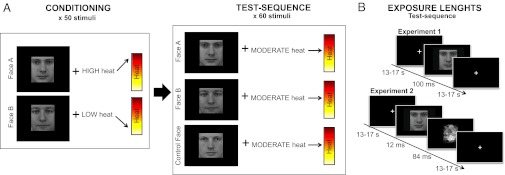Fig. 1.
Experimental procedure and visual exposures. (A) Overview of the experimental design of experiments 1 and 2. Conditioning sequence was performed where clearly visible images of two male faces were used as visual cues, presented on a computer screen. Each face cue was consistently paired with a rapid high or low heat pain stimulus on the subject’s arm. After the conditioning phase, there was a test sequence in which the high cue, low cue, and a neutral control cue were paired with identical moderate heat stimuli. Subjects were asked to rate their pain intensity in response to each stimulus. (B) Consecutive screenshots displayed during the test sequence of experiment 1 and experiment 2. Duration of each exposure is given in milliseconds. In experiment 1, the face cues were exposed long enough for all subjects to clearly recognize them (100 ms) but in experiment 2, the face cues were exposed for only 12 ms and then followed by a mask to prevent conscious recognition. Faces reprinted with permission from ref. 50. Copyright Karolinska Institutet, Department of Clinical Neuroscience, Section of Psychology, Stockholm, Sweden.

